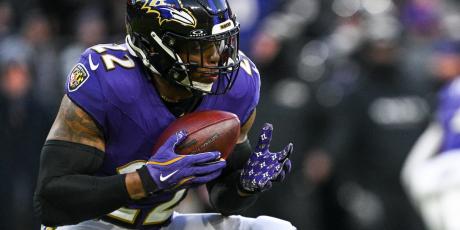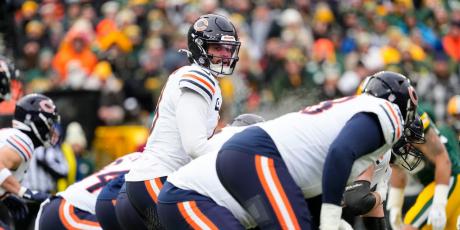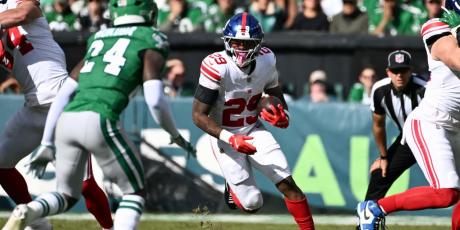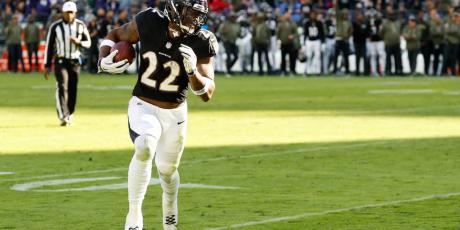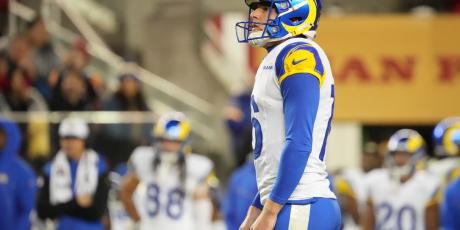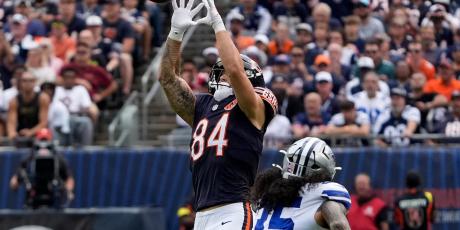New NFL Kickoff Primer With Returners to Target in Fantasy Football
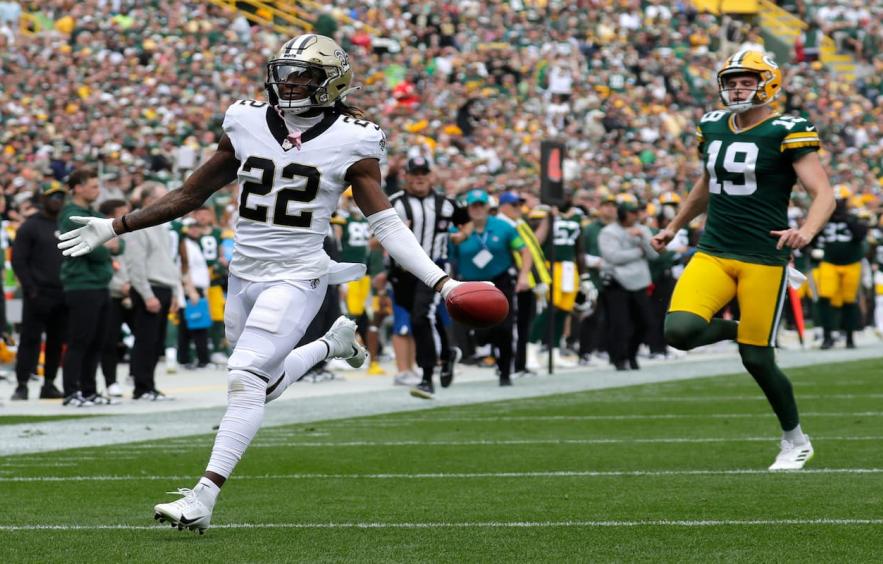
The most exciting part of the first preseason game was watching live action of the NFL’s modified kickoff rule. This rule has massive implications for your fantasy leagues that score kick return yards. The image below provides an overview of the new rule. The most glaring change is the non-kicker players on the kickoff team are much closer to the receiving team’s endzone.
Details of the New NFL Kickoff Rule
Ten players on the kickoff team are required to line up with their lead foot on the receiving team’s 40-yard line (the kickoff start line in the image above). The receiving team is required to have at least nine players in the setup zone, which is the five yards between the 30- and 35-yard lines. Seven of these players must have their lead foot on their own 35-yard line. While the returner(s) is allowed to move at any time, the kickoff team and the receiving team players in the setup zone cannot move until the ball is either caught or hits the ground.
Now, let’s discuss the landing zone, which is the 20 yards between the receiving team’s goal line and their 20-yard line. If a kick falls into the landing zone and stays there, it has to be returned. A kick that hits the landing zone but then bounces into the end zone can be returned or downed, with a downed ball placed on the receiving team’s 20-yard line. If a kick falls short of the landing zone or is kicked out of bounds, it will be placed on the receiving team’s 40-yard line. And finally, kicks that sail through the back of the end zone or land in the landing zone and bounce through the back of the end zone are placed on the receiving team’s 30-yard line.
Differences with the XFL’s Rule
Shawn Syed of Sumer Sports wrote an excellent article The New NFL Kickoff: Breaking Down a Season of XFL Kickoffs to See What We Should Expect. The NFL’s new kickoff rule is a variant of the XFL’s kickoff rule that was used in 2023. As part of the article, he charted every single XFL kickoff with their modified kickoff rule. Before digging into the results of that study, let’s call out a few key differences between the XFL’s rule and what we’ll see in the NFL this season.
Kickers in the XFL were kicking from their own 30-yard line, five yards farther away than NFL kickers. Alternatively, the kickoff start line and setup zone were both five yards closer to the receiving team’s endzone in the XFL. The XFL also required 10 players from their return team to be in the setup zone. The NFL requiring only nine players to be in the setup zone opens up the potential for teams to use two returners, rather than one. There was an additional five-yard penalty on kicks that sailed out of the back of the end zone in the XFL, as they were placed on the receiving team’s 35-yard line, rather than the 30 in the NFL. And finally, the kickoff team wasn’t allowed to move until the ball was caught in the XFL. In the NFL, they’ll be able to move if the ball is caught or if it hits the ground.
Creating an Expectation of NFL Kick Return Yards
With those differences in mind, what Shawn Syed found was that 90% (366/407) of kickoffs were returned in the XFL. Compare that to only 22% of kickoffs in the NFL last season and you get the potential for a massive boost in return yards. Now, I don’t think we get to XFL’s extreme return percentage in the NFL, for reasons I’ll expand on below. But before we get there, let’s look at the average return distance in the XFL. On the sample of 366 kickoffs that were returned, the average play was fielded on the 8-yard line and returned to the 29-yard line, for an average of 21 return yards.
Let’s use those assumptions as a starting point but adjust them for differences in the rules and talent of the players. It’s reasonable to expect that the talent difference between NFL and XFL kickers is large. And these talented NFL kickers will launch the ball five yards closer to the return team. Based on those two factors, my assumption is the average fielded yard line will decrease from the 8-yard line to something closer to the 3-yard line like we saw among the small sample of kicks in the NFL’s first preseason game. But we did see the average return hit 23 yards on that small sample. And I would guess that’s because the kickoff team lines up five yards farther away from the returner, opening up additional room for return yards.
So, that’s one side of the return yard equation. But the other side is how often will we see the ball returned? Seven of the eight kickoffs were returned in the first preseason game, which is reasonably close to the XFL’s average. However, I don’t think we’ve seen how kickers will truly play this yet. There is the possibility that teams just take the touchback and place the ball on the 30-yard line. This avoids the chance of a return TD. But, I don’t think this is likely because, among the 366 kickoffs returned in the XFL, only one was returned for a TD.
What’s more likely is teams will use their very talented kickers and attempt to kick away from the returners, hit the target zone, and skip the ball into the endzone to place the ball on the 20-yard line. That’s exactly what we’ve heard from the Chiefs’ special teams coordinator Dave Toub. They’ve reconsidered using a player like safety Justin Reid as their kicker because the kicker’s skill will be crucial for the kickoff team’s success.
The NFL itself has projected a 55% return rate but has made it clear (for all of the reasons listed above) that this is very difficult to estimate. Let’s go with a 55% return rate and a 23-yard average return. The average NFL team had five kickoffs last season. Assuming 55% of those kickoffs are returned with the new rule for an average of 23 yards, that would provide about 63 return yards per team per game. But that will have a large standard deviation depending on the talent of the opposing team’s kicker, the number of kickoff opportunities, and whether a receiving team uses one or two returners.
Now the fantasy implications of an additional 63 yards are dependent on how your league scores return yards. The Scott Fish Bowl, as an example, gives one fantasy point for every five return yards. So those 63 yards are worth almost 13.0 fantasy points on top of whatever a player scores on offense. With that in mind, let’s dig into who the projected kick returners are by NFL team. And then I’ll highlight a few players whom I have some confidence they’ll be the returners on their team and be involved on offense.
More: 14 Second-Year Running Backs & Wide Receivers to Target in Fantasy Football
Projected Returners By NFL Team
These situations are very much in flux this early in the preseason. With that in mind, the table below shows who I believe the most likely kick returner will be, some other options for the team, and my confidence in the situation as of August 29th. Let me know @StephenHoopes if you feel differently about any of these situations.
Players to Target in Leagues with Return Yard Scoring
Rashid Shaheed
Rashid Shaheed has a history of being an extremely efficient WR. In 2022, Shaheed put up an elite 2.59 yards per route run (YPRR) on 326 routes. On a larger number of routes in 2023, Shaheed’s efficiency dropped but was still above average. That was because his success after the catch dropped by about three yards per reception, partially due to a higher average depth of target. He was able to hit a 57-open score from ESPN Analytics, which is above average, and cleared the first benchmark for receiving yards per game that I found when looking at The Most Predictable Wide Receiver Stats.
And the drumbeat for Shaheed during training camp has been deafening. From a Saints beat reporter: “Shaheed has been so consistent and effective that we’re going to stop talking about him. I’m fairly certain he’s won every 1-on-1 rep he’s taken in camp and won them fairly easily. At one point today, I heard WRs coach Keith Williams instructing him not to take any more reps.”
There is some concern that Shaheed will be such a focal point of the offense that the team won’t want to risk him on special teams. But based on the reports I’ve seen, I still expect him to be the returner. And if that’s the case, he’s an absolute must-draft player depending on how heavily your scoring settings emphasize return yards. In the Scott Fish Bowl, for example, Shaheed’s 8.3 fantasy points per game on offense last year combined with our 13.0 expected return points would’ve made him the WR1 overall, outscoring Tyreek Hill by 1.6 points per game. Now not every league is as insane as the Scott Fish Bowl scoring, but Shaheed has the best combination of offensive involvement and likely return use in the league.
Bucky Irving
One of the main reasons I like Bucky Irving this year is because I view Rachaad White as a prototypical dead-zone RB. While he’s one of the most efficient receiving backs in the league, he’s one of the least efficient rushers. White finished dead last in 2023 with -110 rushing yards over expected (RYOE). Running backs that hit that RYOE number or worse have averaged a 23.7% drop in rushing attempts the following season. That compares to a 2.3% increase in rushing attempts for all other RBs. To hit -110 RYOE, an RB had to have a massive number of attempts and be inefficient on that huge volume.
And rookie Bucky Irving is the main competition the Buccaneers brought in for White. Irving was selected in the fourth round with the 125th overall pick. And my RB prospect model really likes Irving given the importance of receiving work for RBs. He arguably had the best receiving profile in the class with elite reception and YPRR marks. He also had very strong tackle avoidance, elusiveness, and yards after contact in his final season at Oregon. One of the biggest knocks on his profile was his relatively low rush attempts per game.
Additionally, Irving’s combine did not help his ultimate draft selection. Weighing in at only 192 pounds, Irving’s size is absolutely a concern at the next level. And with that small size, we were hoping for a blazing fast 40-time. Unfortunately, that’s not what we got. His 4.55-second 40-yard dash puts his weight-adjusted speed score in a concerningly low bucket.
So, the fit for Irving on the Buccaneers doesn’t make a ton of sense to me. He’s honestly a lot like White but smaller. The role that his college profile suggests he’d succeed in would be a third-down receiving back. But the receiving work is exactly the area where White thrives. But I’m willing to lean into the uncertainty of the low cost of Irving as a bet against White. He’s also already flashed in the return role in training camp, sprinting past the kick coverage for a touchdown on a return rep. Now, I have less confidence than Shaheed that Irving will be the returner, given that the Buccaneers head coach only said “he’s one of the guys training back there”. But he’s worth the bet at cost, especially with the kick return upside.
Marvin Mims
Marvin Mims didn’t have enough targets last season to qualify for my wide receiver analysis. Given that 107 other WRs qualified…that’s a bad sign. He finished the year with a 22/377/1 line. The Broncos head coach Sean Payton kept saying Mims would get more involved on offense and then he…didn’t. So, with that in mind, I’m not particularly excited about the WR3 on perhaps the league’s worst offense. But Mims is absolutely a viable option depending on how much your scoring settings boost return yards. Mims was an excellent returner last year, and Sean Payton referenced Mims as being locked into the return role this year.
Dameon Pierce
Dameon Pierce had a rough 2023 season. His avoided tackles per attempt were ok at about 18%. But otherwise, Pierce finished in the danger zone for every other stat we care about when I looked at The Most Predictable Running Back Stats. He only earned 2.27 yards after contact per attempt, only 6.2% of his attempts went for 10+ yards, and he only averaged about one reception for 7.8 receiving yards per game. His 5.4 fantasy points per game were best left on your waiver wire.
Pierce was not the kick returner for the Texans during their first preseason game, but that might not necessarily be a bad sign. The Texans rested their starters for the contest. It could be a sign they view Pierce as their starting kick returner and didn’t want to open him up to potential injury. There’s not much out there on the Texans’ kick returner competition, but most sites list Pierce as the team’s top kick returner on the depth chart.
Bottom Line
• Based on the NFL’s projected 55% kickoff return rate and my estimated 23-yard average return, a typical returner could see 63 kickoff return yards per game in 2024. Note, this number will vary a lot by game and the NFL itself said the 55% return rate is difficult to estimate.
• However, if you play in a league that scores return yards, plug those yards in for the players listed in the table by team above and see how that changes things.
• A player like Rashid Shaheed will be particularly attractive given his role on the offense, training camp drumbeat about his performance, and how successful he’s been in the return game.


